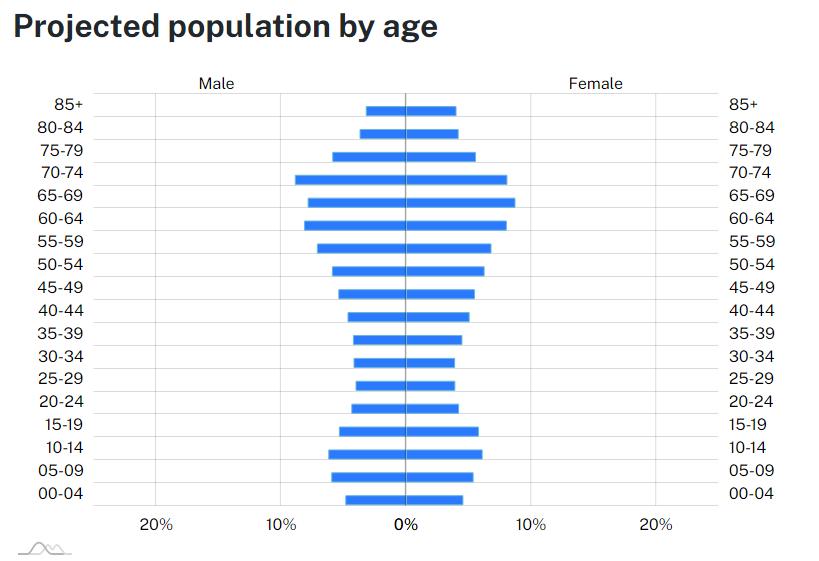Growth Management Strategy





To ensure that growth takes place with adequate services and facilities
To develop settlement patterns that are orderly and efficient with defined limits

To avoid developing areas affected by natural hazards
To protect environmentally sensitive areas, cultural heritage & character
To maintain primary production and promote economic development
To support affordable & appropriate housing
To provide open space & recreation facilities
To facilitate efficient use & provision of energy





6.1% increase since 2011 and 5.1% since 2016 to be 12,899 persons in 2021
persons aged 55 years and above are just under half the population at 45.6% in 2021, up from 39% in 2011 and 42.8% in 2016
Half of the population is within the working age category of 20 to 64 years of age

There were 6,123 private dwellings in 2021. Of these, 85.4% were occupied

There has been a 16.4% decrease in the number of unoccupied private dwellings. This verifies that second homes and holiday houses have become permanently occupied as people relocated from capital cities during the pandemic
Occupancy rates vary across Federation LGA and have decreased from 2.3 persons per dwelling in 2016 to 2.2 persons per dwelling in 2021 for the LGA
88% of dwellings are separate houses. There is some variation in the proportion of separate houses across the three main towns with the highest being in Howlong. All dwellings in the villages are separate houses
The proportion of occupied private dwellings that are rented has decreased by 2.2% since 2016. Just under half of dwellings are owned outright and a third are under mortgage
Pre-school (0-4 years) School age/dependant (5-19 years) Working age (20-64 years) Retirement (65-74 years) Elderly (75+ years)

have forecast that there will be a steady increase of the population to 2041 with a total population of 13,287 persons and total change of 5.6% between 2021 and 2041
Growth is expected to peak in the period 2026 to 2031 with an increase of 1.9% in the numbers of persons in that period

Components of population change are due equally to births and migration into the LGA
the
year





The labour force participation rate in 2016 was 51.3%. A high proportion of residents in Federation LGA were not in the labour force reflecting the high proportion of residents in the older age cohorts
The unemployment rate in 2016 was 4.9%
Agriculture, forestry and fishing accounted for the highest numbers of person employed at 16.6% followed by the manufacturing sector, health care and social assistance, retail trade and construction
The majority of agricultural land was used for dryland cropping with grazing on native vegetation predominant in the north-west of Federation LGA
DPI Agriculture has mapped the southern quarter of the LGA as state significant agricultural land. This corresponds with land that is irrigated


There have been 252 dwellings, 13 dual occupancy dwellings and 10 multi dwellings approved over the period 2017/18 to 2021/22
The bulk of these were in Corowa, Howlong and Mulwala with Mulwala accounting for 43% of all dwelling approvals
The average number of approvals across the 5 year period 2017/18 to 2021/22 in Corowa was 12, in Howlong was 14 and in Mulwala was 21.
The average number of approvals across the high growth 2 year period 2019/20 to 2021/22 in Corowa was 6, in Howlong was 7 and in Mulwala was 10.
The construction value of all approvals has declined each year from over $50 million in 2016/17 to just over $40 million in 2019/20
An average of 34 residential lots have been approved each year over the period 2017/18 to 2021/22
$60,000,000
$50,000,000
$40,000,000
$30,000,000



Rising prices and land shortages - There have been significant rises in land and house prices as a result of global factors including the COVID-19 pandemic, economic volatility and conflicts
Housing stress - Around 40% of households in Federation LGA have a very low to low income relative to the median of $1,187 per week. 35% of households are suffering rental stress and 15% are under mortgage stress
Housing diversity - 88% of dwellings in Federation LGA are separate detached houses and only 10% of housing is medium density such as townhouses, villas and flats. There is a mismatch between the range of housing and the needs of the population for more diversity in housing types
Rural living opportunities - Minimum lot sizes of 250, 100 and 400 hectares apply to subdivision for dwellings in rural zones. A review of minimum lot sizes is necessary to provide opportunities for rural living and rural residential development whilst ensuring food security is not threatened

Change in proportion of separate houses


Servicing constraints – There are shortfalls in the capacity of the reticulated water and sewerage systems to cater for growth in the three towns of Howlong, Corowa and Mulwala. Substantial upgrades and augmentation are required to cater for the existing population and expected growth. Impacts of heavy vehicles on regional and local roads are increasing and maintenance and upgrades to the road network are necessary. Funding needs to be found to carry out these works (presentation on 13 September 2022)
Natural environment and hazards – The presence of threatened species and potential flooding affects urban areas. Land supply estimates need to be revised downwards to account for these constraints. A lack of stormwater drainage infrastructure exacerbates the impacts of flooding on property and water quality of the Murray River and streams



st round – October 2022
workshop
Information sessions (Corowa, Howlong, Mulwala, Urana)
round – first half of 2023
exhibition of the draft strategy for 28 days
display of the draft strategy on Council’s website and in community buildings
information sessions (Corowa, Howlong, Mulwala, Urana)
